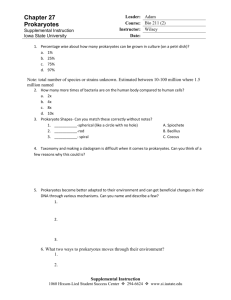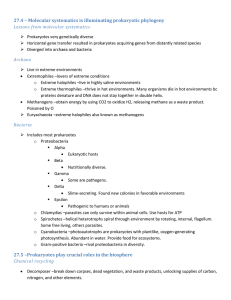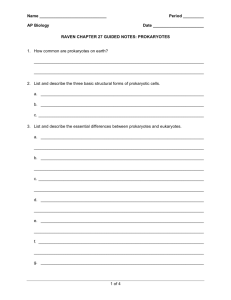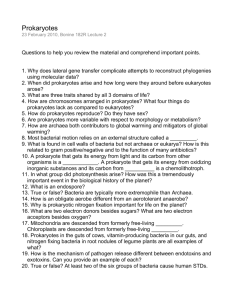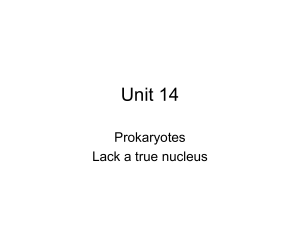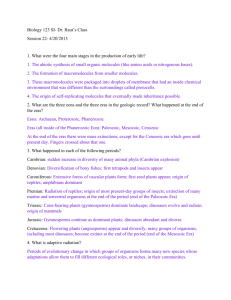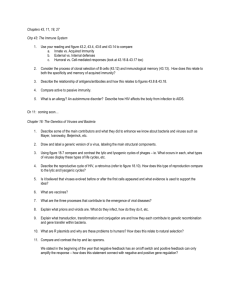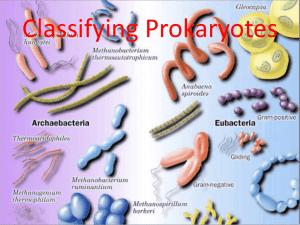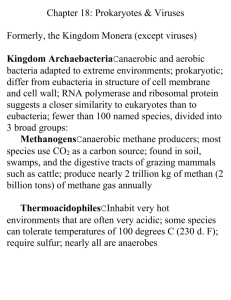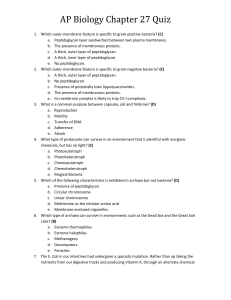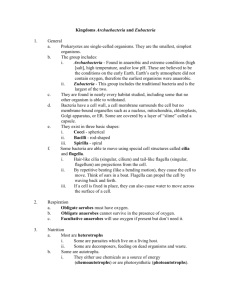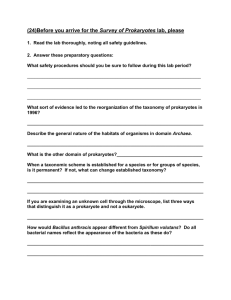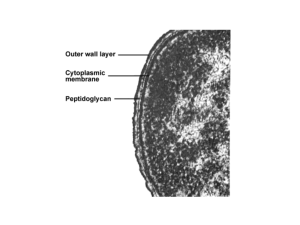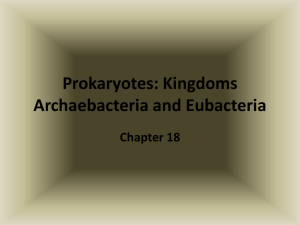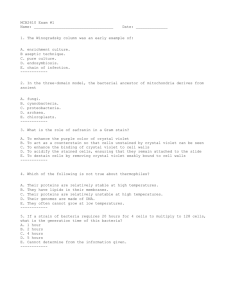CH. 27 1) Phylogeny of prokaryotes. a) Domain Archae
advertisement
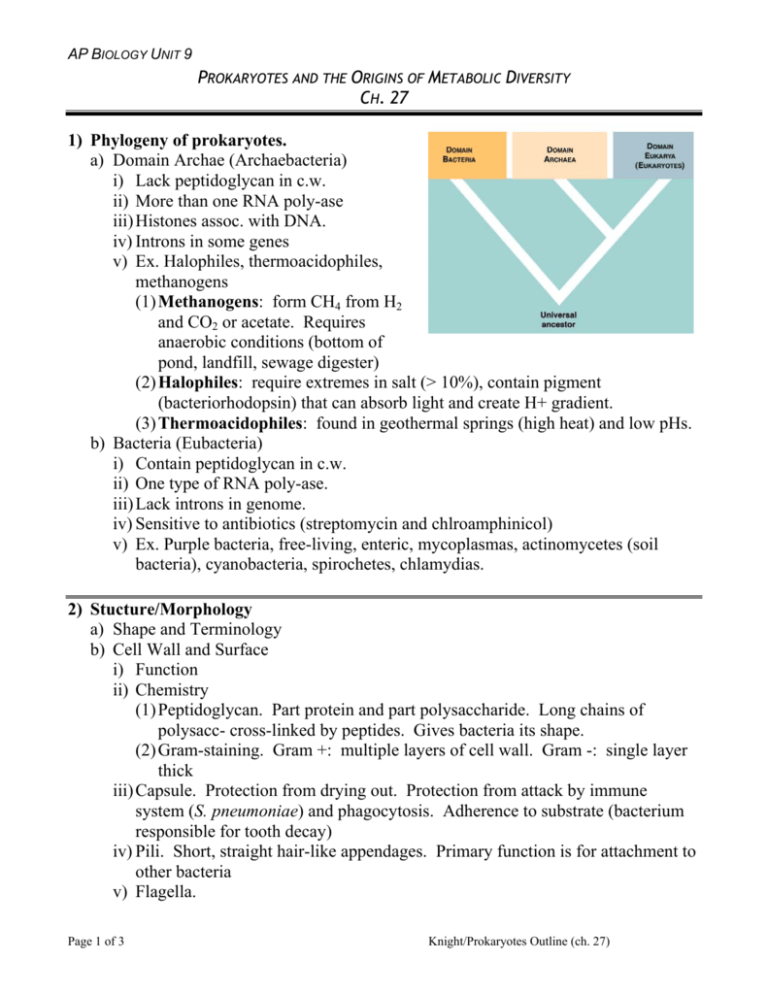
AP BIOLOGY UNIT 9 PROKARYOTES AND THE ORIGINS OF METABOLIC DIVERSITY CH. 27 1) Phylogeny of prokaryotes. a) Domain Archae (Archaebacteria) i) Lack peptidoglycan in c.w. ii) More than one RNA poly-ase iii) Histones assoc. with DNA. iv) Introns in some genes v) Ex. Halophiles, thermoacidophiles, methanogens (1) Methanogens: form CH4 from H2 and CO2 or acetate. Requires anaerobic conditions (bottom of pond, landfill, sewage digester) (2) Halophiles: require extremes in salt (> 10%), contain pigment (bacteriorhodopsin) that can absorb light and create H+ gradient. (3) Thermoacidophiles: found in geothermal springs (high heat) and low pHs. b) Bacteria (Eubacteria) i) Contain peptidoglycan in c.w. ii) One type of RNA poly-ase. iii) Lack introns in genome. iv) Sensitive to antibiotics (streptomycin and chlroamphinicol) v) Ex. Purple bacteria, free-living, enteric, mycoplasmas, actinomycetes (soil bacteria), cyanobacteria, spirochetes, chlamydias. 2) Stucture/Morphology a) Shape and Terminology b) Cell Wall and Surface i) Function ii) Chemistry (1) Peptidoglycan. Part protein and part polysaccharide. Long chains of polysacc- cross-linked by peptides. Gives bacteria its shape. (2) Gram-staining. Gram +: multiple layers of cell wall. Gram -: single layer thick iii) Capsule. Protection from drying out. Protection from attack by immune system (S. pneumoniae) and phagocytosis. Adherence to substrate (bacterium responsible for tooth decay) iv) Pili. Short, straight hair-like appendages. Primary function is for attachment to other bacteria v) Flagella. Page 1 of 3 Knight/Prokaryotes Outline (ch. 27) AP BIOLOGY UNIT 9 3) Motility a) Flagella: Primary function= locomotion. Several flagella will intertwine to form a rope-like structure that turns as a unit which propels the bacterium in a straight line through its media (called a “run”) b) Filaments. Specialized (internalized) structure that allows some bacteria to move through viscous liquids (mud and mucous membranes of host (syphilis can be in the mouth or penis/vagina!) c) Slime gliding d) Taxis. Seek out favorable environments and avoid harmful ones. i) Chemotaxis. Toward nutrients, away from toxins. ii) Phototaxis. Photosynthetic forms swim toward light. iii) Magnetotaxis. Along magnetic flux lines. 4) Prokaryotic genome a) Genophore/Nucleiod region. b) Plasmid 5) Growth, reproduction and genetic exchange a) Binary fission b) Endospore formation. Resting structures that withstand high heat, radiation, desiccation, toxins. Allow survival for hundreds of years. Form during unfavorable conditions. Low in water content (15% vs. 90% of normal cell). Tough wall forms that is one of the toughest biological structures. c) Transformation: extracellular DNA incorporated d) Transduction: exchange via viruses e) Conjugation: F-plasmid and bacteria “sex” 6) Metabolic diversity a) Nutritional modes depend on carbon source and energy source. i) Photoautotrophs: CO2 and Light ii) Chemoautotrophs: CO2 and Inorganic molecules (oxidize H2, H2S, NH3, Fe++ to form proton gradient then synthesize ATP) iii) Photoheterotrophs: Organic molecules and Light iv) Chemoheterotrophs: Organic Molecules and Organic molecules. (1) Saprobes (2) Parasites 7) Oxygen requirements a) Obligate aerobes b) Obligate anaerobes c) Facultative anaerobes Page 2 of 3 Knight/Prokaryotes Outline (ch. 27) AP BIOLOGY UNIT 9 8) Nitrogen cycling a) Nitrogen fixation (N2 Æ NH3) b) Nitrification (NH4+ Æ NO2- & NO3-) c) Denitrification (NO3- Æ N2) 9) Evolution of metabolism a) Origin of glycolysis and chemiosmosis b) Origin of photosynthesis 10) Importance of Prokaryotes a) Ecological cycles i) Decomposers b) Symbiotic relationships (organisms in close contact with each other) i) Mutualism (N-fixers and root nodules) ii) Parasitism (pathogenic strains) c) Opportunistic pathogens i) Endotoxins: lipid portion of lipopolysaccharide outer membrane (part of the cell). Produced by gram negative bacteria. Lower toxicity, relatively heat stable. ii) Exotoxins: Highly toxic proteins that are secreted outside the cell (outside of the cell) that can kill a host cell at extremely low concentrations. Some can be neutralized by antibodies of immune system. Page 3 of 3 Knight/Prokaryotes Outline (ch. 27)


